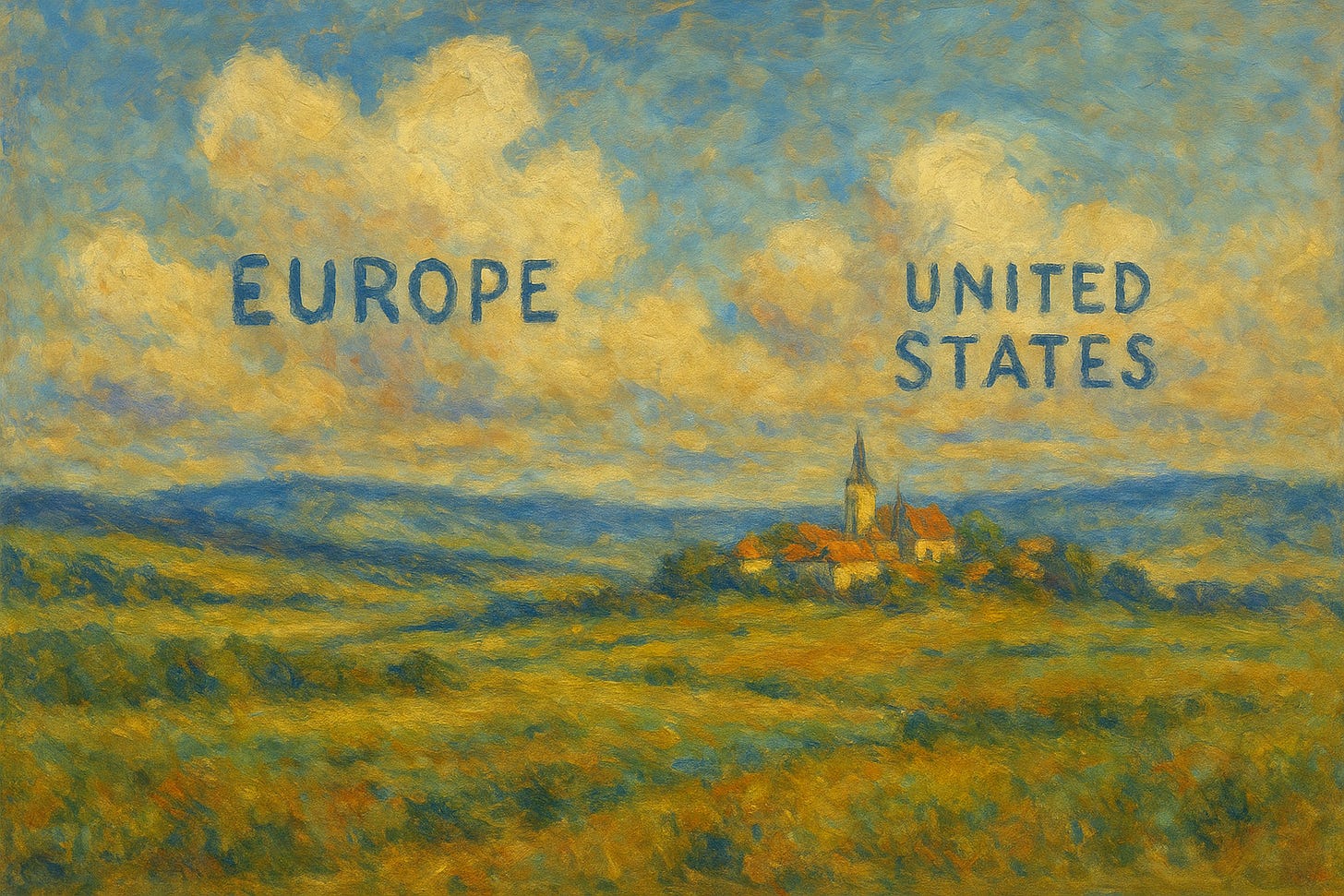Here’s a controversial take.
For the purposes of practical political discussion, it’s more accurate to treat individual European countries like U.S. states and Europe as roughly analogous to the United States.
My partner Laura and I fight about this incessantly. From the European perspective, this thesis can be read as disrespectful toward the sovereignty of countries that have been nations for hundreds of years.
But on the other side, there is some undeniable historical European privilege in Czechia (pop. 10.9 million, GDP $343 billion) having the rights and powers attached to country status while Ohio (pop. 11.8 million, GDP $873 billion) has no formal means of expressing political will in the global theater.
I’m American, so I come at this from an American perspective. But the same thing could be said for the Tianjin Province in China (pop. 14 million, GDP $253.1 billion), the Gujarat state in India (pop. 68 million, GDP $359 billion), and the Ural Federal District in Russia (pop. 12.1 million, GDP $287 billion)—that they are all somewhat structurally equivalent to Czechia in some vague sense, just subsumed by a larger civil national system.
In some ways, this comes down to a basic distinction: civic nationalism, which is rooted in shared political values, legal equality, and voluntary membership in a state (e.g., French republicanism), versus ethnic nationalism, which is based on shared ancestry, language, culture, or religion and emphasizes ascriptive membership—you belong by birth, not by choice (e.g., the German Volksgemeinschaft). While their histories are complicated, many European nations fit into this latter camp when compared to, say, the political thing called “China.”
But either way, one can come to feel like calling both Czechia and China “countries” is a bit like calling both Wyoming and California “states,” each with two senators—it’s just unavoidably unfair. Or, at least, it is an inaccurate descriptor.
Just to throw out some relevant facts: While there are only 27 members of the European Union, there are 44 sovereign countries in Europe (vs. 50 US states). The population of Europe (excluding Russia, lol) is about 600 million, while the population of the US is 336 million. The GDP of Europe is about $23–24 trillion, while the GDP of the US is $30.5 trillion.
Each has similar economic workhorses—for the US, California (GDP $4.2 trillion), and for Europe, Germany (GDP $4.5 trillion). Each has clingers-on too—for the US, Vermont (pop. 650,000, GDP $40 billion), and for Europe, Iceland (pop. 380,000, GDP $30.0 billion).
On the one hand, the EU does not have an army because it is not a country. But on the other hand, it kind of does…? NATO is not a part of the EU. It’s a separate treaty organization. But in practice it is hard to deny that NATO forces function as a de facto European army, providing the basic security function that is the practical purpose of any national military.
In the domain of everyday politics and policy, the EU imposes all sorts of binding agricultural and environmental regulations that have essentially the same effect on politics. In Spain, right-wing parties decry “overbearing” and “tyrannical” bureaucrats in Brussels. There are farmer and truck driver protests. It’s the same shit.
From a sort of structural, agnostic, modern viewpoint, European countries are American states. And I think that, in general, for conversations about practical policy matters, we should start talking that way.
Funny enough, Bernie gets it wrong in both directions. He loves to say shit like “Per capita health care spending: Norway: $6,647 … United States: $11,072 … Number of uninsured/underinsured: Norway: 0; United States: 92 million.”
First, Norway and the US are not even close to equivalent political things. Norway is unbelievably homogenous. It is also tiny, in many material ways the same as Minnesota. And the equivalent thing to the US, the EU—which Norway is not a part of—does not provide universal healthcare.
But the second and more important fact that Bernie’s quip obscures is that his fucking home state of Vermont, unlike Norway, does not provide its residents with universal healthcare.
In 2011, Vermont passed Act 48 to create Green Mountain Care, a state-level single-payer healthcare system intended to provide universal coverage. The plan positioned Vermont as a national leader in health policy innovation, but it was ultimately abandoned in 2014 due to political and economic concerns, particularly the significant tax increases required to fund the program. Although a law establishing universal healthcare remains formally on the books, it is considered aspirational and has not been implemented. The best they’ve been able to do is something called “Dr. Dynasaur,” which is funded by federal Medicaid dollars that provides “near-universal” coverage to children and pregnant women.
Great, but how about Vermont just figures out how to have universal healthcare?
Meanwhile, Czechia has a social health insurance-based universal healthcare system, featuring compulsory contributions, near-complete population coverage, publicly negotiated services, and strong state regulation, that aligns with many European models in delivering accessible care to all residents.
When I bring the idea of “EU countries = US states” up with Laura, I’m often in the wrong. It always comes off in a tone of like, “Oh, you poor little European countries who can’t get over their little language differences and little ritual attachments! How cute! Should we do another world war to figure out if the Germans or French are ethnically superior? Do you even learn about the Marshall Plan in Europe?”
I’m the asshole. And, to Laura’s credit, Spain didn’t even participate in World War II. If there’s any coherent thread in the history of Spain, they’re always on their own program.
But the point is this.
By shifting to think about US states as like European countries, it actually forces us Americans to confront the fact that, while the US itself might not have a lot to learn from Czechia or Norway, Vermont, Arkansas, and California in fact do.




